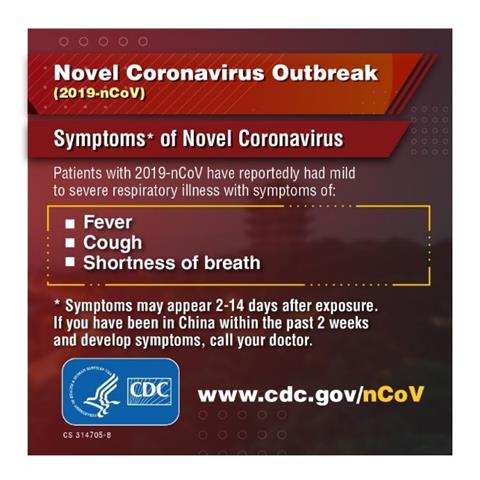The Novel Coronavirus and the Practice of Dentistry
Our practice of dentistry is affected by many factors that we cannot control, such as the weather or the economy. The wisest course for safeguarding our practices is to make every effort to control or moderate those factors that are within our power, including the spread of infection. At present, the health of our patients and practices may be impacted by an emerging illness — the 2019 novel coronavirus (2019-nCoV). To be better informed and prepared for the possible spread of the new coronavirus, let’s look at some background information provided by reliable sources, the Centers for Disease Control and Prevention (CDC) and the World Health Organization (WHO).
According to the CDC, coronaviruses are a family of viruses common in many animal species, including cats, cattle and bats, and do not commonly infect humans. However, some coronaviruses evolve and are transmitted from animals to humans, and these infections can then spread from person to person. New strains of coronavirus recently identified in humans have included severe acute respiratory syndrome coronavirus (SARS-CoV) and Middle East respiratory syndrome coronavirus (MERS-CoV), which caused deadly outbreaks of disease in 2002 and 2012, respectively.

The initial transmission of 2019-nCoV is thought to have come from live animals in a market in Wuhan, China, with subsequent spread of infection occurring through close person-to-person contact. The CDC states that the virus is likely spread via respiratory droplets produced by infected individuals during coughing or sneezing.
The symptoms of 2019-nCoV, which include fever, cough and shortness of breath, can appear two to 14 days after exposure. The severity of illness reportedly ranges from asymptomatic or mild to serious manifestations that have in some cases resulted in death. Seasonal influenza can present with these same symptoms and, due to the timing of this outbreak, can be a confounder in proper diagnosis. Guidance provided by the CDC has two key details that can help preliminarily differentiate between 2019-nCoV and seasonal flu in patients who have a fever or signs and symptoms of lower respiratory illness:
- A history of travel to mainland China in the 14 days prior to the onset of symptoms.
- Close contact with an ill, laboratory-confirmed 2019-nCoV patient in the 14 days prior to the onset of symptoms.
If patients have symptoms and report one of these forms of exposure, they should be asked to wear a surgical mask and isolate themselves from other persons, if possible. The local health department should also be notified.
Please note: Due to high demand, some manufacturers and distributors are limiting the sale of protective gear, including face masks. AGDVANTAGE supplier DHPI is still honoring our agreement and will continue to sell these supplies at the AGD discount. Supplies are limited. For more information, check out AGDVANTAGE.
Now that we have this background, what can we do to help maintain the safety of our dental practice? There is no vaccine against 2019-nCoV, but the CDC has reminded the general public of the recommendations that apply to the prevention of all respiratory viruses:
- Wash your hands often with soap and water for at least 20 seconds, especially after going to the bathroom; before eating; and after blowing your nose, coughing or sneezing.
- If soap and water are not readily available, use an alcohol-based hand sanitizer with at least 60% alcohol. Always wash your hands with soap and water if they are visibly dirty.
- Avoid touching your eyes, nose and mouth with unwashed hands.
- Avoid close contact with people who are sick.
- Stay home when you are sick.
- Cover your cough or sneeze with a tissue, and throw the tissue in the trash.
- Clean and disinfect frequently touched objects and surfaces using a regular household cleaning spray or wipe.
In the practice of dentistry, the aforementioned precautions are part of our everyday practice of infection control, known as standard precautions. Here are some additional guidelines for keeping in front of this issue:
- Discuss the current 2019-nCoV outbreak with your staff. Develop a consistent message that the patient’s well-being is the practice’s No. 1 consideration and that the use of standard precautions keeps everyone safe. You can also find resources on the websites of the Organization for Safety, Asepsis and Prevention and WHO.
- Review the CDC’s standard precaution guidelines with your staff, and make sure that they are being followed.
- Let your patients know that you are practicing these precautions as a routine part of your practice and that your precautions are in compliance with CDC guidelines.
- Download the free public health posters and leaflets offered by the CDC and WHO, and share them with your patients. Among the relevant topics are hand washing (CDC, WHO) and influenza.
Our oral health practices are safe for our patients and staff, but news about emerging diseases can make patients nervous and withdrawn. People may lack basic information or receive conflicting information about current outbreaks. Dental practitioners should stay current on 2019-nCoV and other public health incidents by following the Health Alert Network (HAN), a service of the CDC, for up-to-date information. By staying informed and calm about newsworthy health issues that may affect our practices, we can ensure that our patients will continue to receive the safe, beneficial dental care we have always provided.
